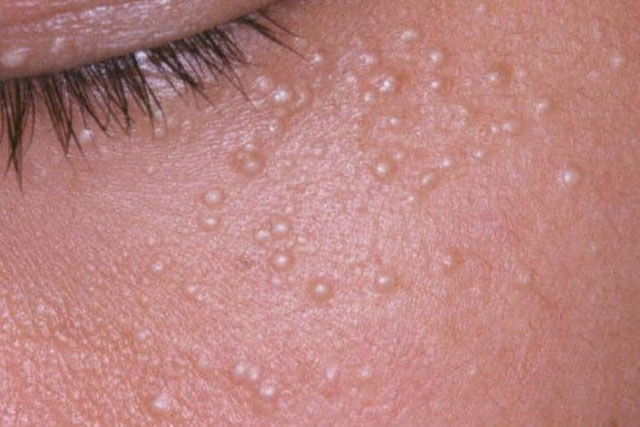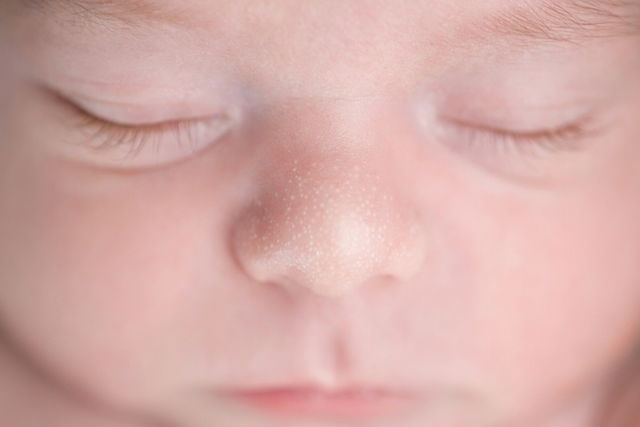What is it:
Milia is a skin condition characterized by small cysts or keratin papules. They can be white or yellow and affect the most superficial layer of the skin. This skin change is caused by excessive sun exposure, use of petroleum-based products on the skin. It can also appear in over-heated babies.
Generally milia appear in regions of the face, like the nose, eyes, cheeks and behind the ear. They can also appear on the neck, hands, back, and in rare cases, the scalp, inside the mouth and around the genitals. Milia papules can cause itchiness, although other symptoms generally do not appear in most cases, nor do they cause skin problems.
A consult with a dermatologist can help to confirm a diagnosis, rule out other skin lesions like an allergic irritation, and remove these small cysts. The dermatologist will assess you to determine the most appropriate treatment approach.

Possible causes
The main causes of milia include:
- Accumulation of dead cells beneath the skin
- Skin damage from burns or sun exposure
- Healing skin in areas where there were blisters
- Use of medications, such as some oral anti-inflammatories and corticosteroid ointments
- Genetic or autoimmune diseases, such as lupus erythematosus or lichen planus
Most of the time, milia appear when dead skin cells are not eliminated through natural peeling. When this happens, the new cells grow over the old cells, which can become trapped and form small balls (cysts).
Bumps on the skin can also be caused by other diseases, such as miliaria, sebaceous hyperplasia and acne, which can sometimes be confused with milia. Learn more about what causes bumps on the skin and how they are treated.
Main symptoms
Milia is a skin alteration that is characterized by visible, pearl-like papules. They may or may not be itchy and also have the following characteristics:
- Similar to a cyst
- About 1 to 3 mm in size
- Clear or yellow-like color
These papules are filled with a gelatinous fluid called keratin, which is a naturally-occurring skin protein. They occur mainly on the nose, forehead, cheeks, eyelids or behind the ears, but can also occur in the genital area or roof of the mouth.
Different types
There are different types of milia that are defined by their cause and location. Some types include:
- Neonatal milia: which occur in about half of newborn babies. It is characterized by small skin cysts that resolve over time. They occur on the nose, cheeks and even inside the mouth.
- Primary milia: which occur in adults. It is characterized by visible, small papules that are found on the eyelids, cheeks, forehead, and in rare cases, in the genital areas.
- Juvenile milia: this type is associated with Rombo syndrome, Gorlin syndrome, Bazex-Dupré-Christol syndrome, paronychia, Gardner syndrome, and other genetic conditions.
- Milia en plaque: which occurs when various milia cysts emerge in the same place, forming a plaque of inflammation on the skin. It usually occurs behind the ear or cheek.
- Traumatic milia: which occurs when milia papules appear in skin areas that are healing or scarring, or when burns result in blisters.
In addition, the prolonged use of skin products, like creams, ointments, petroleum-based make-up, lanolin, corticoides, and hydroquinones can lead to the emergence of milia.

How to get rid of milia
Milium is not considered a serious problem and can sometimes improve without the need for specific treatment. However, if you wish to remove the milium, it is recommended to consult a dermatologist, who can indicate the most appropriate treatment for each case.
The most recommended treatment options for removing milia include:
1. Skin care
Adopting skin care routines, such as cleansing the skin with warm water and using anti-oil soap, moisturizing creams and sunscreen regularly, can help reduce milia and prevent the appearance of new spots.
2. Ointments
The doctor may prescribe ointments based on retinoids or retinoic acid, to stimulate skin renewal and eliminate the spots caused by the milium. Learn more about tretinoin and how it is used.
3. Cryotherapy
Cryotherapy is a type of treatment in which a cold substance is applied to skin lesions, facilitating their removal. This procedure can sometimes be recommended to remove the milium.
4. Milium extraction
In some cases, milium extraction may be indicated through a small procedure performed by a dermatologist. In this case, the doctor usually uses a needle and special sterile instruments to safely remove the bumps.
It is not recommended to try to remove milium cysts as if they were pimples or blackheads or with a needle at home due to the risk of cuts, wounds and infection, which can worsen skin lesions.
Treatment of milia in babies
White milia spots are common in newborn babied due to fat retention in the skin. They usually disappear within a few days without any specific treatment.
In babies, milia generally appear in the summer or on very hot days within the first weeks of the baby's life. They can also emerge with a fever. When sweat cannot pass through pores, like in the nose or cheeks, a blister-like papule can emerge. It is usually fluid-filled and rupture easily.
